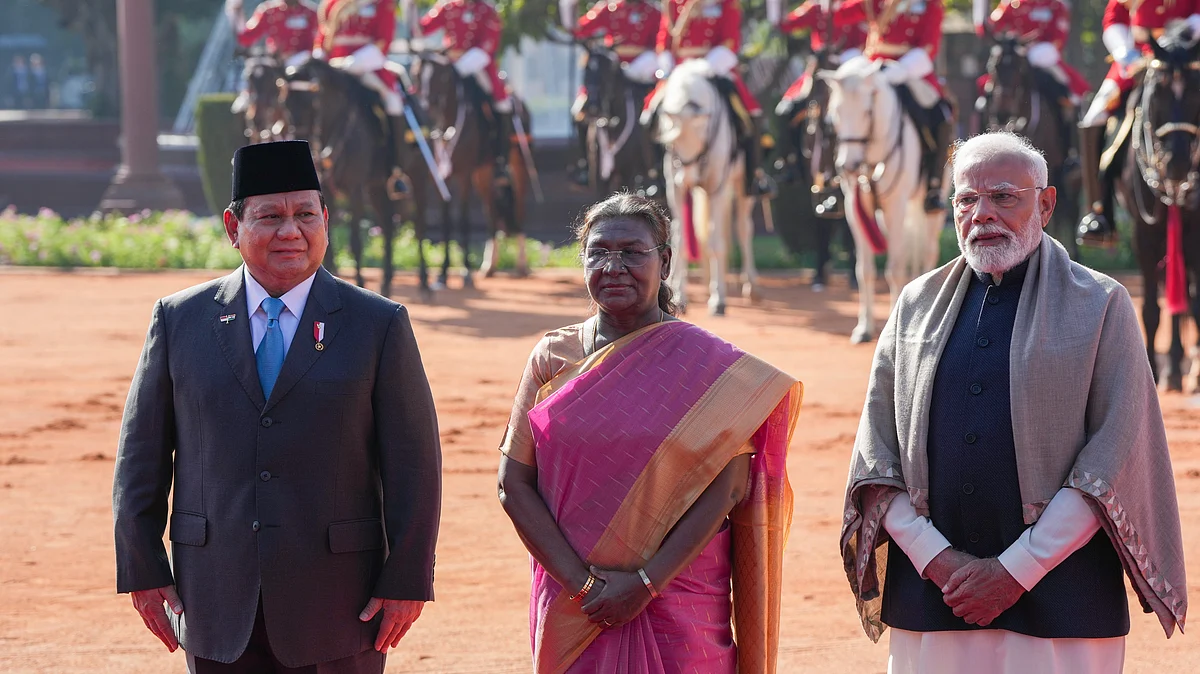
Republic Day Diplomacy: Decoding Indonesian President Subianto's Delhi Sojourn
With the Indonesian strongman Prabowo Subianto in Delhi, the geopolitical ball is in PM Narendra Modi's court.

advertisement
India celebrated its first Republic Day on 26 January 1950 – and in keeping with the fervour of the end of the colonial rule in southern Asia and the enthusiastic embrace of non-alignment by like-minded nations in that heady era, it was appropriate that the chief guest at the first-ever parade was the then Indonesian President Sukarno.
Seventy five years later, another Indonesian President has been accorded this honour, testifying to the historic legacy of the bilateral relationship and the potential it has for consolidating the national interests of both nations in the current decade. President Prabowo Subianto, who assumed office in October last year, is a retired general of the Indonesian Army and served as the defence minister under former President Joko Widodo, his predecessor.
The largest nation in the 10-member Association of Southeast Asian Nations (ASEAN) group, Indonesia is also the world’s fourth largest country with a population of 278 million, a gross domestic product (GDP) of $1.37 trillion, and per capita income of almost $5,000. Yet, the bilateral relationship remains underdeveloped, and a few indicators are illustrative.
Looking East
Collectively, ASEAN accounts for 11 percent of India’s total global trade and it is diminutive Singapore, the city-state with which Delhi has the most comprehensive regional partnership, that is India’s largest trading partner.
For two proximate nations whose combined GDP is in excess of $5 trillion, a bilateral trade figure of under $30 billion points to the vast potential for steady growth. Subianto's visit will thus hopefully prove to be the catalyst.
The only direct connection is from Delhi to Bali, the much-acclaimed tourist island.
India embarked upon its ‘Look East’ policy under the stewardship of then Prime Minister PV Narasimha Rao in the early 1990s as part of the economic liberalisation that Delhi was compelled to undertake. Since then, India’s ASEAN policy has acquired greater traction.
To his credit, Prime Minister Narendra Modi transmuted this into an ‘Act East’ policy at the 12th India-ASEAN Summit in 2014, and in his first term, Indonesia received visible high-level summit attention.
Historically, the maritime domain lies at the core of the bilateral relationship. The Indian influence in many parts of Southeast Asia, more so in places like Bali, was enabled by this very linkage.
In the modern period, both Widodo and Modi have in their own way sought to highlight the centrality of the oceans in their national strategic framework. This has been differently envisioned. In 2014, President Widodo introduced the concept of Indonesia (the world’s largest archipelagic nation whose 18,000 islands span the Pacific and Indian Oceans) as the critical ‘maritime fulcrum’ in the Indo-Pacific.
A year later, in 2015, PM Modi unveiled his vision of SAGAR (security and growth for all in the Indian Ocean region) and highlighted India’s credibility in the maritime domain. In December 2016, the two nations signed an ambitious ‘Statement on Maritime Cooperation’, which remains a work in progress.
Leading the Global South
While India and Indonesia have different regional geopolitical aspirations and anxieties, both are committed to being leading voices of the global South. This is a shared objective, and common ground can be evolved, as was the case when the G20 baton was passed.
In this regard, China is the other major interlocutor, and it is instructive that soon after winning the presidential election in early 2024, President-elect Subianto made his first visit to China (he was still the defence minister). Soon after his inauguration in October, the first official visit he made was to Beijing.
But instead of placing all its eggs in one basket, Jakarta has maintained a deft balance in its relations with both China and the US. India will have to harmonise its own ties with Indonesia against this backdrop.
Striking a Balance
It is the maritime domain and the Indo-Pacific that will provide both opportunities and challenges for India and Indonesia, and these could be addressed jointly to mutual benefit.
Conversely, the low-hanging fruit in the maritime sector needs to be identified as part of the SAGAR effort, where India can share its own expertise and capabilities and, in this regard, maritime domain awareness (MDA) is ripe for plucking.
High-quality MDA that India could share will help Indonesia in protecting itself, and its proven maritime resources from a range of criminal and illegal activities in the vast oceanic spaces it has to monitor to safeguard its interests.
Progressively, this could pave the way for a joint programme that looks at the Blue Economy in a more effective manner than is the case now. Both nations are dealing with similar internal security issues such as curbing Islamic terrorism and maintaining societal harmony in a multi-religious polity and can share best practices.
The Subianto visit should become the catalyst to realise the vast potential in the bilateral relationship. Fast-tracking a direct Delhi-Jakarta flight will be an auspicious beginning.
(C Uday Bhaskar is a leading expert on strategic affairs. He is currently Director, Society for Policy Studies. This is an opinion piece. All views expressed are the author’s own. The Quint neither endorses nor is responsible for them.)
- Access to all paywalled content on site
- Ad-free experience across The Quint
- Early previews of our Special Projects
Published: undefined